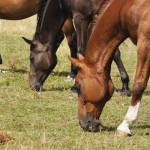Oleander: Avoidable Cause of Colic and Death in Horses

Several species of plants, shrubs, trees, and weeds pose health risks to horses if ingested. Oleander, a perennial decorative shrub, serves as one such example.
“All parts of the oleander plant, especially the seeds, dried leaves, and flowers, contain toxins, namely oleandrin and digoxin. Those toxins cause abnormalities in the cellular flow of electrolytes, ultimately causing decreased contractility of the heart cells and negatively impacting kidney function. Further, physical damage to the gastrointestinal tract can occur as a direct effect of the toxins on cells,” explained Kathleen Crandell, Ph.D., an equine nutritionist with Kentucky Equine Research (KER).
Classic signs of oleander toxicity are relatively nonspecific, including colic, lethargy, and anorexia. In the case of oleander toxicity, however, the presence of concurrent cardiac abnormalities, including arrhythmia, is often documented. Kidney disease also commonly occurs in cases of oleander toxicity.
The dangers of oleander ingestion were recently highlighted in two studies. One* of those described the death of two Miniature Horses after ingesting as little as 0.28-0.38 kg (one-half to three-quarters of a pound) of dried plant material, including dried leaves or flowers found on the ground. The authors noted that Miniature Horses may be more susceptible to toxicity.
In the second publication, medical records of 130 horses referred to the University of California-Davis Veterinary Medical Teaching Hospital and suspected of oleander exposure were reviewed. Of those, 30 had confirmed oleander intoxication by identifying the presence of oleandrin or digoxin in blood, urine, or gastrointestinal tract samples. Some of the key findings of that study were:
- A variety of breeds, sexes, and ages were affected, with Arabians and Miniature Horses overrepresented;
- About 13% of horses were from facilities where other horses may also have been exposed to oleander and showed signs of toxicity;
- Many horses had either been moved to a new pasture or facility, or had recently escaped from their stall or pasture;
- An overwhelming 66% of owners were aware they had oleander on their property; and
- Half of the horses died due to toxicity.
It is important to note that the latter study only included horses referred to a veterinary hospital. Many more horses are likely exposed to oleander each year and either treated or perish in the field.
“In addition to removing oleander shrubs from your farm, be aware that horses can also be exposed to oleander in contaminated forage. Purchase quality forage and inspect it carefully as you’re feeding it. Ensure it is free from not only molds and dust but also visible contaminants, weeds, animal carcasses, and blister beetles,” added Crandell. “If you find an unidentifiable plant or a proliferation of weeds in a bale of hay, it is best to not feed it.”
Oleander is primarily found in the southernmost coastal states, including California, Florida, Georgia, South Carolina, North Carolina, Arizona, and Texas, as well as South America, Australia, Africa, Asia, and southern Europe.
*Butler, J., S. Khan, and G. Scarzella. Fatal oleander toxicosis in two miniature horses. Journal of the American Animal Hospital Association. In press.
**Renier, A.C., P.H. Kass, K. F. Madesian, et al. 2013. Oleander toxicosis in equids: 30 cases (1995-2010). Journal of the American Veterinary Medical Association. 242(4):540-549.








